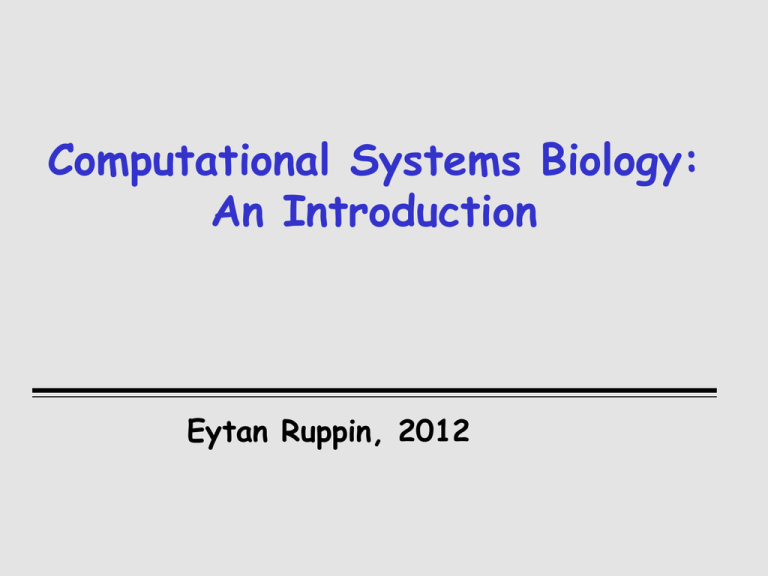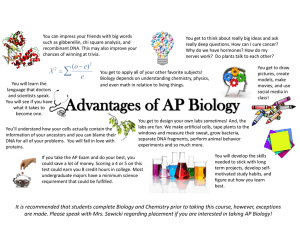Gene Expression Analysis, DNA Chips and Genetic Networks
advertisement

Computational Systems Biology: An Introduction Eytan Ruppin, 2012 השראה :קוראים לי ריי קורצווייל ואני אחיה • לנצח בגיל 17הוא לימד מחשב להלחין מוזיקה• , בגיל 27המציא את הסורק ,ובעשורים הבאים הפך למיליונר בזכות מאות פטנטים וחזה את מהפכות האינטרנט והסלולר .עכשיו ,בגיל ,60נביא ההייטק ריי קורצווייל גילה שאנחנו בדרך לחיי נצח 1. Molecular biology – a (very) quick recap.. The Cell • Basic unit of life. • Carries complete characteristics of the species. • All cells store hereditary information in DNA. • All cells transform DNA to proteins, which determine cell’s structure and function. • Two classes: eukaryotes (with nucleus) and prokaryotes (without). http://regentsprep.org/Regents/biology/units/organization/cell.gif http://www.ornl.gov/hgmis/publicat/tko/index.htm DNA The hard disk RNA One program transcription protein Its output translation Gene expression DNA PremRNA transcription Mature mRNA splicing protein translation Gene expression DNA PremRNA transcription Mature mRNA splicing protein translation Transcription factors (TFs) control transcription by binding to specific DNA sequence motifs. Gene The Human Genome: numbers • • • • 23 pairs of chromosomes ~3,200,000,000 bases ~25,000 genes Gene length: 1000-3000 bases, spanning 30-40,000 bases • ~1,000,000 protein variants Model Organisms • Eukaryotes; increasing complexity • Easy to store, manipulate. Budding yeast • 1 cell • 6K genes Nematode worm • 959 cells • 19K genes Fruit fly • vertebrate • 14K genes mouse • mammal • 30K genes High-throughput measurement Protein-protein Protein-DNA (transcriptional) interaction (PPI): yeast two-hybrid Genetic interactions interactions: chip-on-chip DNA RNA Genome: Transcriptome: Sequencing technologies Microarrays protein Proteome: Various assays 2. Systems Biology The Reductionist Approach to Biological Research • Explanations of things ought to be continually reduced to the very simplest entities • Identifying individual genes, proteins and cells, and studying their specific functions The Reductionist Approach to Biological Research (20th century biology) Explanations of things ought to be continually reduced to the very simplest entities Can this approach explain the behavior of a complex system? Building models from parts lists •High throughput technologies signal the end of reductionism in biology Why Build Models? (Jay Bailey, 1998) • 1. To organize disparate information into a coherent whole • 2. To think (and calculate) logically about what components and interactions are important in a complex system. • 3. To discover new strategies • 4. To make important corrections to the conventional wisdom • 5. To understand the essential qualitative features • "One is neither too scrupulous and sincere, nor too subjected to nature; but one is more or less master of his model, and especially of his means of expression" When one is a master of his own model.. So what is Systems Biology? • The study of the mechanisms underlying complex biological processes as integrated systems of many interacting components. – collection of large sets of experimental data – proposal of mathematical models that might account for at least some significant aspects of this data set – accurate computer solution of the mathematical equations to obtain numerical predictions, – assessment of the quality of the model by comparing numerical simulations with the experimental data. • First described in 1999 by Leroy Hood – Director of the Institute for Systems Biology What’s it good for? • Basic Science/”Understanding Life” • Predicting Phenotype from Genotype • Understanding/Predicting – – – – Metabolism Cellular signal trasduction Cell-Cell Communication Pathogenicity/Toxicity • Biology in silico.. Virtual life.. PubMed abstracts indicate a growing interest in Systems Biology Human genome completed 3. Biological Networks From genomics to genetic circuits • The coordinated action of multiple gene products can be viewed as a network Transcriptional Regulatory Network • Nodes – transcription factors (TFs) and genes; • Edges – directed from transcription factor to the genes it regulates • Reflect the cell’s genetic regulatory circuitry • Derived through: ▲ Chromatin IP ▲ Microarrays S. cerevisiae 1062 TFs, X genes 1149 interactions Protein-Protein Interaction (PPI) Networks • • • • Nodes – proteins; Edges – interactions Reflect the cell’s machinery and signlaing pathways. High-throughput experiments: ▲ Protein coIP ▲ Yeast two-hybrid S. cerevisiae 4389 proteins 14319 interactions Metabolic Networks • Nodes – metabolites; Edges – biochemical reactions • Reflect the cell’s metabolic circuitry • Derived through: ▲ Biochemistry knowledge ▲ Metabolic flux measurements S. cerevisiae 1062 metabolites 1149 reactions Systems Biology: Network States There are many sources of information about biological networks Biological networks operate in the crowded intra‐cellular environment 4. How do we model the complex biological processes encoded in these networks? Modeling the Network Function •A dynamic system with differential equations •Requires unknown data on kinetic constants and concentrations Kinetic models Approx. kinetics Abstraction Signaling Metabolic level Constraint-based analysis •Constraint-based modeling •Boolean and discrete models, bayesian models, linear models, etc Conventional functional models Topological analysis Regulatory •Topological analysis •Degree distribution, motifs, functional modules PPI 30 Types of models • • • • • Data models – reconstruction Topological – structure of networks Steady state – linear algebra Dynamic states – ODEs Thermal fluctuations – noise, stochastic ODEs • Sensitivity – MCA, etc Interim Summary • • • • • The genotype‐phenotype relationship is fundamental in biology Systems biology promises to make this relationship mechanistic The core paradigm is a four step process – Components‐>networks‐>in silico models‐>phenotype Network reconstruction is foundational to the field and a common denominator Models are built to describe steady states (capabilities) and dynamics states • And now to Monty Python something completely different.. • The Future as seen at Present New upcoming Data • The revolution in genome sequencing technologies • Which leads also to new gene expression technologies • microRNA chips • Large scale protein abundance data • Large scale metabolomics data • Completing the identification of cellular networks • Large scale individual cell measurements in high temporal resolution Research Questions & Challenges – I. Basic Science • The riddle of embryonic development • How are cells regulated? • The riddle of `junk’ DNA and the hidden world of mRNA • How and to what extent does the normal cellular genotype determine the phenotype? – Epigenetics.. • The emergent properties of tissues and organs • Evolutionary systems biology – the search for LUCA, the origins of multi-cellularity, the ascent of man.. Research Questions & Challenges – II. Applications • Charting the pathophysiology of human diseases • Identifying new drugs and combinations of drugs • Stems cell research and tissue and organ replacement • Whats can microrganisms do for you? • Metagenomics and the art of sailing.. • Personalized Medicine Some potential computational avenues • Genome association & CN studies • New approaches for modeling integrated cellular functions – in silico cellular biology • Models of tissues and systems • “Interfacing” with the community and the literature.. My lab: Don’t ask what Sysbio can do for you, ask what you can do for Sysbio • Studying cancer metabolism and predicting and testing new anti-cancer therapies • Computational methods for predicting biomarkers and disease diagnosis • Searching for new antibiotics that are resistant to resistance… • Building and studying the gut metabolome • The evolution of human brains.. • Metabolism of stem cells, Alzheimer’s disease, diabetes. • Fighting aging and extending human lifespan



